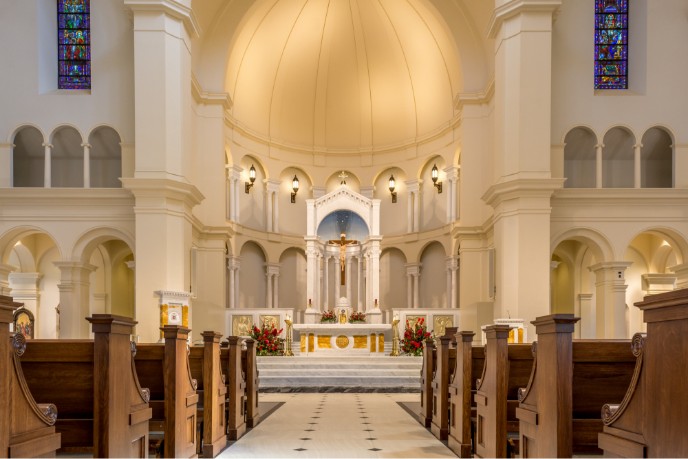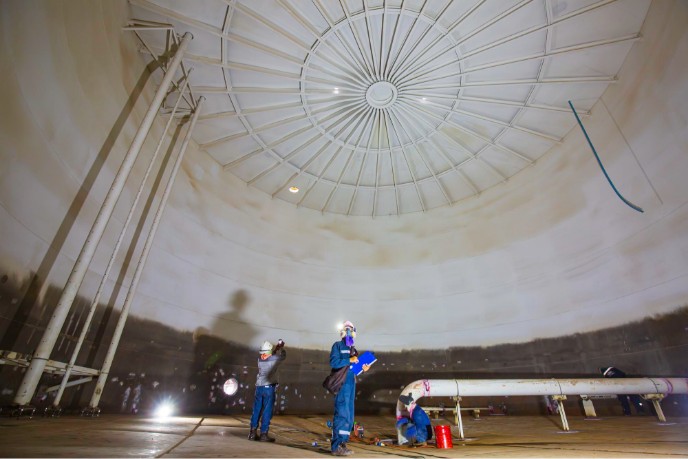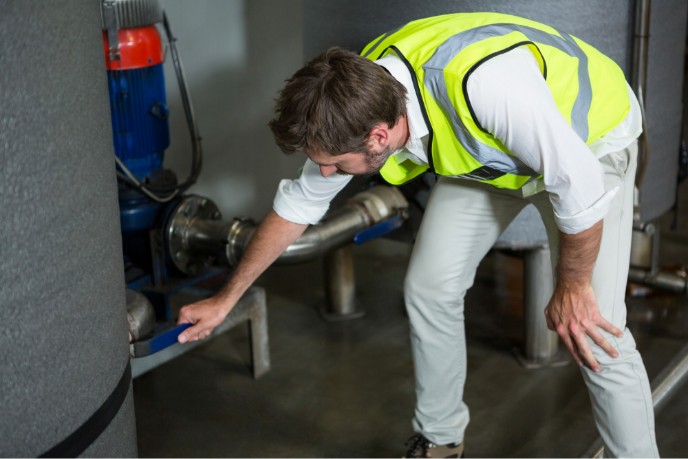
7 Tips for Effective Church Facility Management
In our communities, churches are places of worship, beacons of hope, and centers for community engagement. The role these sacred spaces play extends beyond Sunday services. They also include a myriad of activities and events throughout the week. In this context, church facility management is essential in ensuring the church's continued success and positive impact.
This article will examine strategies, from establishing clear goals to embracing a Church Facility Management Solution such as CMMS software. By the end of this blog, you'll learn the importance of church facility management and actionable insights to transform your church into a well-managed and thriving hub for your community.
What is Church Facility Management?
Church Facility Management is the coordinated effort to oversee, maintain, and optimize a church or religious institution's physical infrastructure and spaces. It involves various tasks, such as planning, maintenance, safety measures, and logistical coordination, to ensure that the church's physical assets are used effectively and efficiently. Effective facility management ensures that the building, grounds, and amenities remain safe, functional, and conducive to the congregation's needs.

Improving Community Engagement with Effective Facility Management
Effective church facility management is not just about maintaining bricks and mortar; it's about facilitating the church's broader mission and strengthening community engagement.
- Creating a Welcoming Space: A well-maintained and inviting church facility will attract new members and visitors. When people feel comfortable and welcomed, they are more inclined to engage with the church's activities and services.
- Supporting Diverse Activities: Churches are often hubs of various community events, from educational classes to charitable initiatives. Proper facility management ensures these activities have the necessary infrastructure, resources, and scheduling support.
- Safety and Security: Ensuring the safety of congregants and visitors is paramount. Adequate facility management includes fire safety, accessible pathways, and security systems, all contributing to a sense of security and peace of mind.
- Resource Optimization: Efficient facility management can also result in cost savings. When resources are wisely allocated, more can be invested in programs and services that benefit the community.
- Community Outreach: Many churches use their facilities for outreach programs, serving as shelters during emergencies and offering meeting spaces for local organizations. Proper facility management ensures these spaces are available and functional when needed.

Tip 1: Establish Clear Goals and Objectives
The Significance of Setting Clear Objectives for Facility Management
Direction and Focus: Objectives provide a clear sense of direction. They help facility managers and church leaders understand what needs to be accomplished and prioritize tasks accordingly.
Measurement of Success: Objectives offer a concrete means of measuring success. They allow you to determine whether you've achieved your goals, enabling you to make informed decisions and adjustments.
Accountability: Clear objectives foster accountability within the church community. When everyone understands the goals, tracking progress and ensuring that responsibilities are met is easier.
Aligning Objectives with the Church's Mission and Vision
Unity of Purpose: When facility management objectives are aligned with the church's mission and vision, they create a unified sense of purpose within the congregation. Everyone understands the "why" behind what they are doing.
Efficiency and Impact: Aligning objectives allows the church to optimize its resources. Instead of dispersing efforts in different directions, everything works together to achieve a common goal, resulting in greater efficiency and impact.
Coordinated Efforts: It promotes coordination between various church functions. Facility management, outreach programs, worship services, and other activities complement each other when their objectives are aligned.
Examples of Specific Goals for Church Facility Management
Maintenance Excellence: Ensure all facilities are well-maintained, with specific goals like "Perform monthly HVAC inspections" or "Complete annual roof inspections and repairs." (Refer church maintenance checklist)
Safety and Security: Improve safety measures with objectives such as "Implement a fire safety training program for staff and volunteers" or "Upgrade security systems to include access control."
Resource Optimization: Set objectives to maximize resource utilization, like "Reduce energy consumption by 10% through energy-efficient upgrades" or "Optimize room scheduling to increase facility utilization by 20%."
Community Engagement: Foster community engagement through goals such as "Host quarterly community events" or "Expand facility use for local non-profit organizations."
Financial Stewardship: Ensure responsible financial management with goals like "Maintain a facility management budget with a 5% contingency fund" or "Identify cost-saving opportunities in facility operations."

Tip 2: Create a Realistic and Sustainable Budget
The Role of Budgeting in Effective Facility Management
Resource Allocation: Budgets help allocate resources (money, time, and staffing or volunteers) effectively. They ensure funds are available for essential maintenance, repairs, and improvements.
Preventative Maintenance: Budgets enable planned preventative maintenance, reducing the likelihood of costly emergency repairs. This proactive approach can save the church money in the long run.
Stewardship: Budgeting embodies the principle of stewardship, ensuring that financial resources are used wisely and responsibly to support the church's mission.
Tips for Creating a Realistic and Sustainable Budget
Assess Current Needs: Begin by thoroughly assessing your church's current facility needs. Identify maintenance requirements, safety upgrades, and any long-term improvements. Having a documented maintenance backlog with cost estimates is very helpful.
Prioritize Projects: Prioritize projects based on urgency and impact. Ensure that essential maintenance needs are addressed before considering cosmetic or optional upgrades.
Research Costs: Research and obtain quotes for maintenance and improvement projects. Be realistic about the costs involved, including labor, materials, and permits.
Incorporate Contingencies: Budgets should include a contingency fund (typically 10-20% of the total budget) to account for unexpected expenses or project overruns.
Plan for Sustainability: Consider long-term sustainability in your budget. For example, Investing in energy-efficient systems may lead to cost savings over time.
Allocate Funds for Routine Maintenance: Pay attention to routine maintenance expenses, such as cleaning, landscaping, and pest control. These often-overlooked costs add up over time.
Involve Stakeholders: Collaborate with church leaders, facility managers, and financial experts to ensure the budget aligns with the church's overall goals.
Tip 3: Schedule Regular Maintenance and Inspections
The Significance of Routine Maintenance
Preserving Asset Value: Regular maintenance ensures that your church facilities remain in good condition over time, maintaining their value and longevity.
Preventing Costly Repairs: Addressing minor issues before they escalate into major problems can save your church considerable money and resources.
Essential Maintenance Tasks for Church Facilities
HVAC Systems: Regularly service and clean heating, ventilation, and air conditioning systems to ensure they operate efficiently.
Plumbing: Address issues promptly to prevent leaks and water damage, including checking faucets, toilets, and pipes.
Roofing: Inspect the roof for signs of damage or wear, and repair or replace shingles or roofing material as needed.
Electrical Systems: Conduct periodic inspections of electrical systems to identify and address any safety concerns or malfunctions.
Safety Measures: Regularly test and maintain fire alarms and extinguishers, smoke detectors, and emergency lighting to ensure the safety of occupants.
Grounds and Landscaping: Maintain the landscaping, sidewalks, and parking areas to improve the overall appearance and safety of the property.
Interior Spaces: Ensure that interior spaces are well-maintained, including painting, flooring, and furniture repairs or replacements as necessary.
Benefits of Scheduled Inspections
Early Problem Identification: Regular inspections can identify minor issues before they become major problems, saving your church from costly repairs.
Improved Safety: Identifying and addressing safety hazards during inspections ensures the safety of your congregation and visitors.
Extended Equipment Life: Regular maintenance and inspections can extend the lifespan of critical systems and equipment, reducing the need for premature replacements.
Better Planning: Inspections provide valuable data for long-term planning, helping budget for maintenance and renovations effectively.
Energy Efficiency: Well-maintained systems, such as HVAC and lighting, operate more efficiently, leading to potential energy savings.
Consistent Aesthetics: Inspections help maintain the visual appeal of your church facilities, creating a positive atmosphere for worship and community gatherings.

Tip 4: Create Facility Use Policies
Process of Scheduling Church Events and Activities
Scheduling church events and activities is a multifaceted process that requires careful planning and coordination:
Assessment of Needs: Begin by assessing the needs of your congregation and the community. What types of events and activities are in demand? How often are they held?
Resource Inventory: Identify available resources, including rooms, equipment, and staffing. Determine their availability and limitations.
Prioritization: Prioritize events based on their importance and impact. Events that align closely with the church's mission may be prioritized.
Reservation System: Implement a reservation system or software to manage requests for facility use. Ensure it is accessible to church members and external groups.
Communication: Maintain open communication with event organizers to clarify expectations, responsibilities, and fees associated with facility use.
Conflict Resolution: Have a process in place for handling conflicting requests. Consider factors such as frequency, significance, and the church's overall mission.
Tip 5: Use a Church Facility Management Solution such as a CMMS
Benefits of a CMMS for Church Facility Management
Streamlined Maintenance: Church maintenance software automates maintenance scheduling, ensuring that essential tasks aren’t missed. Using a CMMS reduces the risk of equipment failure and costly repairs.
Resource Optimization: CMMS software helps churches allocate resources efficiently. You can track the use of equipment, work orders, projects, vendors, and labor and materials, leading to cost savings.
Improved Communication: These tools provide a centralized platform for communication among staff and volunteers. Everyone can access schedules, report issues, and stay informed.
Data-driven Decisions: CMMS solutions collect data on facility repairs and maintenance history. Analyzing this data helps churches make data-driven decisions about repairs and improvements.
Remote Access: Almost all CMMS systems today offer remote access, allowing facility managers to monitor and manage facilities from anywhere, enhancing flexibility and responsiveness.
Recommendations for Selecting and Implementing Technology Solutions Like CMMS Software
When selecting and implementing technology solutions like CMMS, consider the following recommendations:
Needs Assessment: Conduct a comprehensive assessment of your church's facility management needs. Identify pain points and areas where technology can provide the most significant benefits.
Vendor Evaluation: Research and compare CMMS vendors. Look for solutions that align with your specific requirements, budget, and scalability.
User Training: Ensure staff and volunteers receive adequate training on the chosen technology solution. User proficiency is essential to maximize its benefits.
Data Migration: If transitioning from manual processes (paper and pen, spreadsheets) or an older system, plan for data migration to avoid data loss or duplication during the implementation phase.
Integration: Consider how the CMMS will integrate with other church management systems to create a seamless workflow.
Feedback and Iteration: Encourage users to provide feedback and be open to adjusting the system for continuous improvement.
Security and Data Privacy: Ensure that the chosen technology solution meets security and data privacy standards, especially when handling sensitive church information.
Software Costs: Ensure the CMMS works with your budget. Churches are not-for-profit organizations, and software costs for subscription and implementation should be considered. Many providers offer discounts for not-for-profit organizations. When evaluating different solutions, inquire about not-for-profit discounts and understand recurring and nonrecurring costs for training and professional services.
Tip 6: Train Your Facility Staff and Volunteers
Importance of Investing in Staff and Volunteer Training
Skill Improvement: Training equips staff and volunteers with the skills and knowledge to perform their roles effectively, ensuring that facility management tasks are executed professionally.
Adaptability: Ongoing training helps your team stay current with industry best practices and emerging technologies, making them more adaptable to changing circumstances.
Improved Performance: Well-trained staff and volunteers are more likely to identify and address issues promptly, contributing to the overall success of your church facility management.
Tips for Effective Delegation within the Facility Management Team
Clear Communication: Communicate your expectations, objectives, and responsibilities clearly to avoid misunderstandings and conflicts.
Empower and Trust: Delegate tasks and responsibilities based on team members' strengths and expertise. Trust your team to deliver results.
Provide Feedback: Offer constructive feedback regularly to acknowledge achievements and provide guidance for improvement.
Encourage Innovation: Create an environment where team members can suggest innovative solutions and improvements.
Team Building: Foster a sense of camaraderie and teamwork among staff and volunteers. Encourage collaboration and mutual support.
Recognize Contributions: Acknowledge and celebrate the contributions of your team members. Recognizing their efforts boosts morale and motivation.
Continual Learning: Lead by example in pursuing continuous learning and development. Show your team that growth is a lifelong journey.
Tip 7: Gather Feedback for Continuous Improvement
Ways to Gather Feedback from Church Members and Visitors
Surveys: Create regular surveys, whether online or paper-based, to collect feedback on facility experiences, events, and overall satisfaction. Qualtrics and Google Forms are easy to use and have free options.
Suggestion Box: Place suggestion boxes in prominent locations within the church, allowing people to submit feedback anonymously.
Feedback Forms: Provide feedback forms at events, services, or your church website, enabling attendees to share their thoughts and suggestions.
Online Platforms: Utilize social media, email, or dedicated online platforms to create discussion forums where people can share their opinions.
One-on-One Conversations: Encourage open-door policies, where church members and visitors can schedule meetings or have informal conversations with facility management staff.
Sustainability and Environmental Considerations
Sustainability has become an imperative in facility management, driven by the urgent need to protect our environment and reduce our carbon footprint. Here are some practical suggestions to help your church reduce its environmental footprint:
Energy-Efficient Lighting: Replace traditional lighting with LED or energy-efficient bulbs. Consider installing motion sensors to reduce unnecessary lighting.
HVAC Efficiency: Regularly maintain and upgrade HVAC systems for optimal energy efficiency. Implement programmable thermostats to regulate temperature when spaces are not in use.
Solar Panels: Explore installing solar panels on your church roof to generate clean, renewable energy and reduce electricity costs.
Water Conservation: Implement water-saving measures such as low-flow faucets, toilets, and rainwater harvesting for landscaping.
Green Landscaping: Use native and drought-resistant plants in your landscaping to reduce water usage. Implement sustainable landscaping practices like mulching.
Reduced Waste: To reduce disposable waste, encourage using reusable dishes and utensils for church events.
Education and Advocacy: Educate your congregation about the importance of sustainability and encourage them to adopt eco-friendly practices.
Sustainability in facility management is a moral imperative and a financially savvy choice for churches. By implementing eco-friendly practices and technologies, your church can reduce its environmental footprint, inspire positive change in the community, and enjoy long-term cost savings that can be reinvested in your mission and programs.
TABLE OF CONTENTS
Keep Reading
Now that 2026 is here, it’s a great time to assess what can be achieved in maintenance ...
13 Jan 2026
2026 is when the role of a CMMS Software in capital allocation comes to the fore. This is the ...
12 Jan 2026
Choosing the right work order software is no longer optional for maintenance teams in 2026. ...
6 Jan 2026
By 2026, CMMS platforms will no longer be the limiting factor in maintenance performance. ...
30 Dec 2025
Spare parts management within maintenance can make the difference between a problem-free ...
16 Dec 2025
Every maintenance team eventually faces the same question: When should we repair, and when ...
12 Dec 2025
Enterprise Asset Management (EAM) software has become a cornerstone for organizations aiming ...
12 Dec 2025
Unexpected equipment breakdowns can disrupt operations, increase repair costs, and reduce ...
11 Dec 2025
Businesses are always looking for ways to improve efficiencies, reduce costs, and improve ...
9 Dec 2025
The longest U.S. federal government shutdown to date lasted 43 days, beginning on October 1, ...
5 Dec 2025
Every maintenance professional faces it sooner or later — that critical time when an aging ...
18 Nov 2025
The term 'best' is often used loosely, without a clear understanding of its context or ...
14 Nov 2025
In the not too distant past, maintenance strategies have been defined by reaction—fixing ...
13 Nov 2025
Tax season is the time of year that often sends a ripple of anxiety through many of us. The ...
11 Nov 2025
Selecting a Computerized Maintenance Management System (CMMS) can, at first glance, be an ...
4 Nov 2025
In healthcare facilities, equipment uptime involves more than achieving operational ...
31 Oct 2025
Companies are subject to economic ups and downs, also known as economic volatility. Today, ...
30 Oct 2025
Maintenance challenges are a constant struggle, with unplanned downtime costing manufacturers ...
27 Oct 2025
Last winter, a maintenance technician at a U.S. paper mill ignored a predictive alert that ...
10 Oct 2025
Many organizations proudly say they “have a CMMS,” but ownership alone doesn’t equal ...
9 Oct 2025





